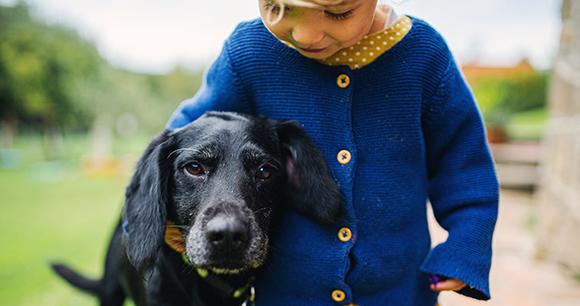
Washington, DC—The Animal Welfare Institute (AWI) endorses the Child and Animal Abuse Detection and Reporting Act (H.R. 8733), reintroduced yesterday by Reps. Ann McLane Kuster (D-NH) and Jeff Van Drew (R-NJ). This legislation would amend the Child Abuse Prevention and Treatment Act (CAPTA) to require that data collected by the federal government from state child protection agencies include information about animal abuse as a risk factor for child abuse.
Weighing this additional factor can help identify opportunities to prevent both child and animal abuse or suggest when more specialized interventions are needed. The bill was first introduced in the US House of Representatives in 2019, but was not taken up before the 116th Congress ended.
“In a violent household, companion animals are often victims of the same abusive behaviors that harm children, intimate partners, and vulnerable adults,” said Nancy Blaney, director of government affairs for AWI. Often, the first person to identify a child in a dangerous situation is a law enforcement officer responding to an animal cruelty call. There is an urgent need for more comprehensive information about these patterns so that social service providers can understand how to intervene safely and effectively.”
As authorized by CAPTA in 1988, the Department of Health and Human Services established the National Child Abuse and Neglect Data System (NCANDS) to compile information from states about the nearly 700,000 American children abused annually. Case reports in NCANDS include a variety of details, such as the type of abuse a child suffered or whether the caregiver had a substance abuse disorder. This data helps researchers and service providers better understand the factors associated with child abuse. Animal abuse is one well-established factor, however, that is not considered under the current law.
Information collected under NCANDS has been used to determine, for example, that children whose families face multiple stressors are at a higher risk of being repeatedly referred to child protective services, and that some types of mistreatment are more likely to recur than others. By tracking child abuse cases related to animal abuse as provided for under the Child and Animal Abuse Detection and Reporting Act, NCANDS would offer another valuable tool to prioritize prevention and intervention.
“As a mother and animal lover, I am deeply disturbed by the degree to which child and animal abuse co-occurs,” Kuster said. “Our government must do more to protect both our children and animals. I am proud to introduce this legislation that will direct the Department of Health and Human Services (HHS) to gather information and analyze cases where both kids and pets are abused. Having this information will enhance our understanding of these abhorrent behaviors and provide a better foundation for screening, prevention, and treatment programs.”
“It is a sad reality that in homes filled with violence, pets often endure the same mistreatment as children and other vulnerable family members,” said Van Drew. “By connecting the dots between animal cruelty and child abuse in households, we are empowering officials to identify when to intervene earlier and helping to prevent further mistreatment from taking place. This bill is an important step forward to protect every member of our community, human and animal alike.”
Click here for more information about the link between violence against animals and violence against humans.
Marjorie Fishman, Animal Welfare Institute
[email protected], (202) 446-2128
The Animal Welfare Institute (awionline.org) is a nonprofit charitable organization founded in 1951 and dedicated to reducing animal suffering caused by people. AWI engages policymakers, scientists, industry, and the public to achieve better treatment of animals everywhere—in the laboratory, on the farm, in commerce, at home, and in the wild. Follow us on Facebook, X (formerly Twitter), and Instagram for updates and other important animal protection news.